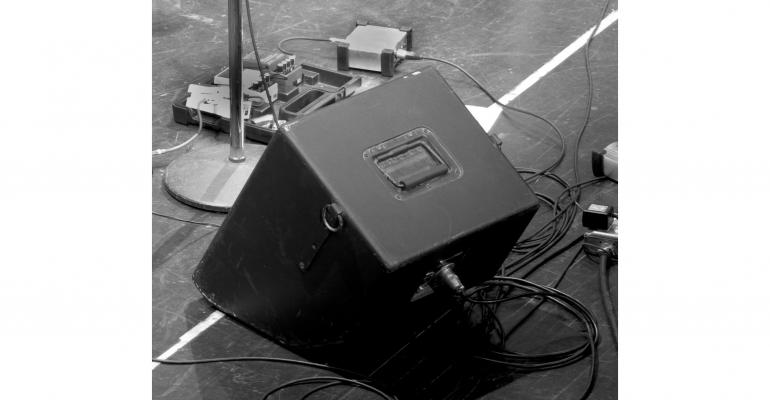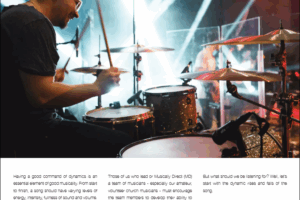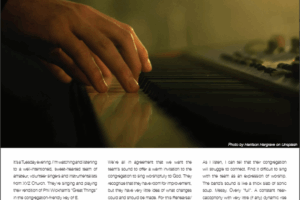Take this link to read Grant’s article as featured in the July issue of Worship…

VOCALISTS: TOP 10 TIPS FOR A BETTER OPEN SPEAKER MONITOR MIX (PART 2)
By Grant Norsworthy
With the welcome resurgence of the emphasis on congregational singing as the imperative, churches who have not yet made the switch to in-ear monitors (IEMs) are tempted to hold onto their open speaker monitors – at least for their vocalists. Many – especially the leaders of congregational worship through songs – are actually ditching their IEM’s and going back to “old fashioned” floor wedges.
This might seem like a regression to some. Why would anyone reject the conventional wisdom and undeniable advantages of the newer technology?
Sure – not everyone will agree. To each their own! But the alternative thinking flows along these lines:
“If my role is to invite the Church to sing truths, prayers and praises to God, then I need to hear how well they’re doing that. IEMs create a physical and sonic barrier between me and the most important people in the ‘band’ – the congregation. I need to share the vibrating air – the sound in the room – with the people!”
In PART 1 of this Blog Post I gave the first 5 of my Top 10 Tips for a Better Open Speaker Monitor Mix. If you missed it, you’ll want to go to the previous issue and check it out. But, without further ado, here are the last 5!
#5 REINFORCEMENT
Don’t try to use your monitor as the only thing you’re listening to. Instead, use the monitor speaker to augment what you would be hearing without it. Just fill in gaps! Yes, you should have a sense of all the elements that are coming together – from the band and congregation – to make our overall sound. But you probably won’t need bass guitar in your mix. It can be “heard” on your skin and through your feet. If there are unshielded acoustic drums or a guitar amp on the platform, you probably won’t need them. If there’s enough of your voice in the room through the FOH, just use the monitor to bring some clarity and immediacy to your sound.
#4 KNOW WHAT YOU’RE AIMING FOR
You want a monitor sound that is as close to a natural sound as possible. Monitors should simply make the sounds a little louder so as to match the level of the instruments around you. That’s what will be most inspiring.
Here’s a great thing to do: Have your vocalists form an inward facing circle away from the microphones. Without instrument, sing a chorus of a song that you all know well. Listen deeply and intentionally to how that sounds. It might help to shut your eyes and concentrate. Then immediately move to the mics and sing again. Your monitor sound should be very similar. Amplified and coming from the floor, sure, but it should still be a natural sound and an even blend.
#3 EQUALIZATION (EQ)
You don’t need to become a tech nerd, but it’s going to really help if you learn some EQ language that can be understood by the audio technician. Listen – REALLY listen – to the sound of your monitor and find words to describe what you hear. You need to communicate effectively so the tech can make the necessary adjustments. Adjectives like “harsh”, “boxy”, or “brittle”, are great. As are sentences like, “It sounds like I’m underwater!” or “under a blanket”. Audio techs know what to do with that information.
And if you really want to speak the tech language, here’s what’s carried me through decades of asking for monitor EQ adjustments: The sound of “ch” (like in “chicken”) and the “ss” (of “sausage”) are pretty much isolated to “4K” (4 kilohertz) and “5K” (5 kilohertz) in audio geek speak. Make those sounds into your mic. Listen to your monitor and ask for adjustments to 4K and 5K as needed. You don’t want too little or too much.
4K and 5K are the most important frequencies to get right in order to have natural monitor sound that can inspire and have clarity without any excess of volume. We MUST get the EQ right before we make any volume level adjustments.
#2 TURN DOWN (NOT UP)
Stop. Listen. Don’t ask for anything to be turned up (especially your own voice) until you have FULLY explored turning other things down. Quite frequently, it’s the drums (especially snare drum and cymbals) or electric guitar amps that are in competition with the register of the human voice. Sometimes it’s other vocalists, especially if you’re sharing a monitor mix. Open speaker monitors work best when the overall platform volume is low. Everyone needs to be on the same page with this. Selfless choices will have to be made.
#1 REJECT THE EGO-CENTRIC MIX
This is the best piece of advice I was ever given about setting a monitor mix: “You don’t need to hear JUST yourself. You need to JUST hear yourself.” Don’t set a me-me-mix. Have a well balanced mix where your sonic contribution is part of the overall “picture”. Not the dominant feature.
If we’re going to use open speaker monitors, let’s do it right this time! There’s no place for “Everything louder than everything else” volume levels as we worship God through songs.
For a practical demonstration on this same subject, watch this short video.
This article was first published by Worship Tech Director of the WFX Network on February 7, 2019


